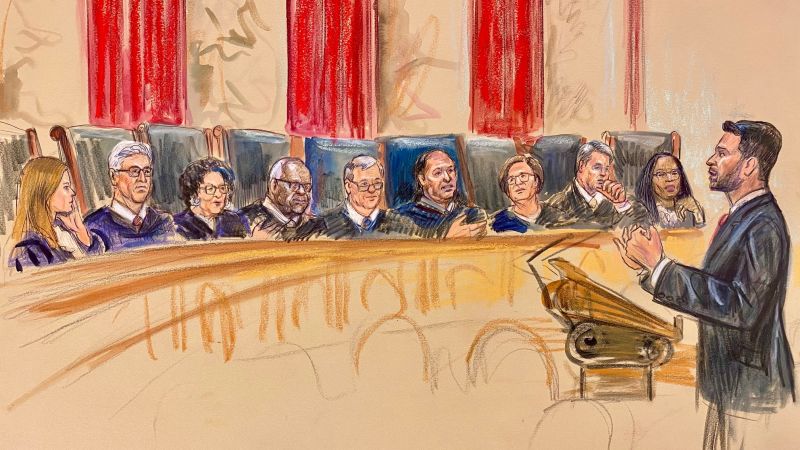CNN
—
As the Supreme Court bears down on the most contentious stretch of its annual session, the justices have been taking detours in opinions that reveal policy preferences and simmering grievances.
When Supreme Court Justice Brett Kavanaugh delivered excerpts of a recent decision on environmental regulation from the bench, he segued into a zealous policy-driven admonition about government “delay upon delay” and the consequences for America’s infrastructure.
“(T)hat in turn means fewer and more expensive railroads, airports, wind turbines, transmission lines, dams, housing developments, highways, bridges, subways, stadiums, arenas, data centers, and the like,” Kavanaugh went on to write in his opinion. “And that also means fewer jobs, as new projects become difficult to finance and build in a timely fashion.”
Days later, when Justice Clarence Thomas joined a unanimous job-bias ruling, he penned a separate opinion that included an extraneous footnote decrying DEI. “American employers have long been ‘obsessed’ with ‘diversity, equity, and inclusion’ initiatives and affirmative action plans,” he wrote, joined by Justice Neil Gorsuch, and referring to a brief from America First Legal Foundation, founded by Stephen Miller, now a top policy adviser to President Donald Trump. “Initiatives of this kind have often led to overt discrimination against those perceived to be in the majority.”
And last week, when Justice Ketanji Brown Jackson dissented from the court’s decision giving the Department of Government Efficiency (DOGE) access to Social Security Administration data, she stepped back and juxtaposed lower court judges’ handling of Trump litigation with that of the conservative high-court majority.
She variously described the lower court judges as “hard at work”; engaged in “thorough evaluations”; and issuing “well-reasoned interim judgments.” The Supreme Court’s conservative majority, on the other hand, “dons its emergency-responder gear, rushes to the scene, and uses its equitable power to fan the flames rather than extinguish them.”
Jackson has also made clear her disdain for the Trump agenda, referring in one case to its “robotic rollout” of a policy cancelling teacher grants.
Policy preferences have long lurked in the background of Supreme Court opinions, despite Chief Justice John Roberts’ insistence that the justices, as “umpires,” are concerned with the law, not societal consequences. What stands out these days is the willingness to overtly echo political talking points.
Conflicts on the law, policy and all else among the justices are likely to deepen as they resolve their most difficult cases before a traditional end-of-June deadline. Still to be decided are disputes over state bans on medical care for transgender youths, parents’ ability to remove their elementary-school children from LGBTQ-themed instruction, and the Trump administration’s effort to end birthright citizenship.
Cases arising from Trump’s orders, appealed to the court on its emergency docket rather than the regular oral-argument calendar, will continue beyond this annual session.
The justices often split along ideological and political lines. Conservatives Roberts, Thomas, Gorsuch, Kavanaugh, Samuel Alito and Amy Coney Barrett were named by Republican presidents; the three liberals, Jackson, Sonia Sotomayor, and Elena Kagan were named by Democratic presidents.
Such fault lines emerged in a late May case over Trump’s firing of the heads of two independent agencies, the National Labor Relations Board and the Merit Systems Protection Board.
The dispute filed on the court’s emergency docket, among several flowing from dozens of Trump orders since he returned to the White House on January 20, drew widespread public interest because of the possible impact on the Federal Reserve and the country’s economy.
If Trump had the ability to remove leaders at the two independent labor-related boards, he could arguably fire Fed Chair Jerome Powell, threatening the longstanding independence of the Fed and destabilizing markets.
In mid-April, Trump wrote on Truth Social, “Powell’s termination cannot come fast enough.” He blasted Powell for his measured steps on interest rates and for warnings about Trump’s sweeping tariffs.
On Thursday at the White House, Trump again complained about interest rates, called Powell a “numbskull,” but said he was not going to fire him.
Chief Justice Roberts shepherded the court’s action in the case, as the majority issued an order that allowed Trump to remove, at least for the time being, the two board members who’d begun the dispute. The majority then specifically added language to exempt the Federal Reserve.
The exception – superfluous to the legal issue at hand – appeared to respond to the political atmosphere and possible criticism that the court’s action was endangering the Federal Reserve and US economy.
Justice Kagan called out the majority’s move as a reaction to the politics of the day.
In a dissenting opinion joined by the two other liberals, Kagan condemned the majority for favoring “the President over our precedent” regarding the removal of agency heads. (A 1935 case, Humphrey’s Executor v. United States, limited the president’s ability to fire such independent officers.)
“If the idea is to reassure the markets,” Kagan wrote, “a simpler – and more judicial – approach would have been to deny the President’s” appeal for immediate relief.
“Because one way of making new law on the emergency docket (the deprecation of Humphrey’s) turns out to require yet another (the creation of a bespoke Federal Reserve exception).”

